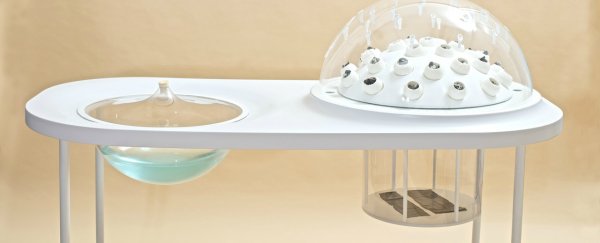Microbiologists in the Netherlands have teamed up with Austrian industrial designers to come up with an amazing solution to our plastic problem - now we can simply eat it, via an edible fungi.
It's been a good year for promising plastic breakthroughs, with scientists in November developing a plastic that breaks down fully in just three hours. Now the European team has developed a device called the Fungi Mutarium, which uses fungi to safely break down plastic, in turn growing an edible food source.
The prototype machine works on small bits of thin plastic - like the kind used in shopping bags - and first uses UV light to sterilise and kickstart their decomposition.
This UV-treated plastic is then placed in a small pod made from agar, which is an edible, algae-based type of gelatin.
These pods are then placed in the dome-like "growth sphere" and liquified fungi sprouts are poured over them.
In just a few weeks, fungi begins to grow out of the pods, using the plastic to feed its development. After several months, the plastic will be completely decomposed and you're left with nothing but an agar cup filled with edible fluffy white mycelium - the soft, vegetative part of a fungus.
"We were both really inspired about the idea that something digests plastic but then still creates edible biomass," Katharina Unger, one of the two industrial designers from the studio Livin, who worked on the project, told Kaleigh Rogers from Motherboard. They also wanted to find some new and innovative solutions to food shortages around the world.
"Farmers are increasingly dealing with extreme environmental conditions to produce food," Unger explained to Adele Peters from Co.Exist. "Fungi Mutarium is a projection of how new biotechnologies might be applied to grow edible material on so far harmful or even toxic waste material."
Amazingly, these mushrooms are, in theory, safe to eat, because although they can fully digest plastic, they do this without accumulating the toxic compounds - although the designers admit that more testing would need to be done on their safety before the mutarium could be commercialised.
While it all sounds very cool, we know what you're thinking - what do the mushrooms taste like? The microbiologists have so far used oyster mushroom and split gill mushrooms in the system, which are two of the most popular mushrooms in the world.
According to Unger, they're pretty tasty, and can be eaten whole.
"It starts off being very neutral, but it can also get a bit nutty and spicy in taste. It really depends on the strain, actually," Unger told Rogers.
The team also developed some recipes to flavour the agar cups that the mushroom is inside, which range from savoury to a sweet one with peaches and yoghurt.
As you can see in the video below, the whole set-up looks pretty futuristic.
Unfortunately however, there's still a long way to go before this device can be used more widely.
Right now the fact that it takes months to break down tiny bits of plastic means that it's not super appealing to the market. But the team are now looking into how they can improve the process and also scale it up for mass use.
"We know that there's potential to speed up this process simply by optimising the processes around it: temperature, humidity, the perfect microclimate for this fungi to colonise the plastic material," Unger told Rogers.
"Also, though it's more controversial, there is genetic modification. What happens if you modify the organism so that it can process the materials more quickly?"
They also hope the prototype will make people think a little differently about plastic waste and the potential ways we can grow food.
While it's still got a long way to go, the fact that scientists have now estimated there are 5.25 trillion bits of plastic polluting our oceans shows just how badly we need some new solutions to dealing with plastic waste.
And if we can find a way to do that while also helping to feed the population sustainably, then that's pretty awesome.
Source: Motherboard, Co.Exist
